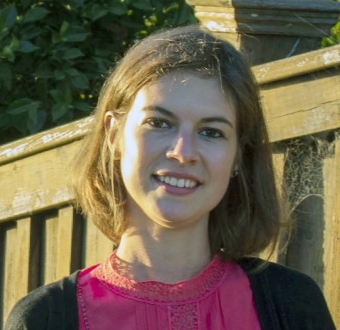
The UCSB Materials Department welcomes Assistant Professor Raphaële Clément, to the Inorganic Materials area of research. The overall goal of Prof. Clément’s research is to elucidate the relationship between the structure and (photo)electrochemical properties of inorganic materials used in solar cells and rechargeable batteries, a key step towards designing new clean energy generation and storage systems with superior performance.
In Prof. Clément’s group, electrode materials and electrode-electrolyte interfaces are investigated using complementary experimental and theoretical tools. Whilst diffraction-based techniques are used to characterize the average (long-range) structure of solids, many materials with promising electrical properties exhibit some long-range disorder when synthesized, or become increasingly disordered or even amorphous during operation, leading to loss of information in X-ray or neutron diffraction. On the other hand, the structure of most electrochemically-active materials retains some short-range order during operation, and techniques probing the local structure of solids are particularly powerful. Among these, we employ magnetic resonance spectroscopy to gain insight into the reactions and structural changes taking place during operation in the bulk electrode materials, using both solid-state Nuclear Magnetic Resonance (NMR) and Electron Paramagnetic resonance (EPR) spectroscopy, and at the electrode-electrolyte interface, using Dynamic Nuclear Polarization (DNP) to enhance the NMR signal from the interface. We investigate (photo)electrochemical systems both ex situ, by studying a series of samples stopped at different stages of function, and in situ / in operando, e.g., as the battery is charged and discharged or the photoelectrochemical cell is exposed to light. Alongside our experimental work, we use theoretical modeling to understand which structural processes and chemical transformations are likely to take place during operation, as well as to assist the assignment of the NMR and EPR spectra.
Prof. Clément is looking for excellent and strongly motivated students who should expect to develop a large range of experimental skills, from the synthesis of inorganic compounds to the use of electrochemical characterization and magnetic resonance techniques, as well as expertise in theoretical modeling. Post-doctoral fellows interested in the development of magnetic resonance techniques applied to (photo)electrochemical systems are also welcome to contact Raphaële Clément for details.
Prof. Clément’s group will benefit from the strongly collaborative environment of the Materials Department and will include collaborations with groups in Physics, Chemistry, and Chemical Engineering at UCSB. The large range of NMR and EPR spectrometers available on campus and UCSB’s Terahertz facility will provide capabilities for state-of-the-art magnetic resonance measurements for the investigation of electrochemical materials.
Prof. Clément is coming to UCSB from the University of California Berkeley, where she currently is a postdoctoral scholar in Materials Science. During her Ph.D., she developed expertise in the experimental characterization of paramagnetic Li-ion and Na-ion battery materials and in the computation of paramagnetic NMR/EPR parameters. She received her Ph.D. in Chemistry, and her B.A. and M.Sc. in Natural Sciences, from the University of Cambridge. She spent her junior undergraduate year as an exchange student at the Massachusetts Institute of Technology.
Welcome, Prof. Clément!



